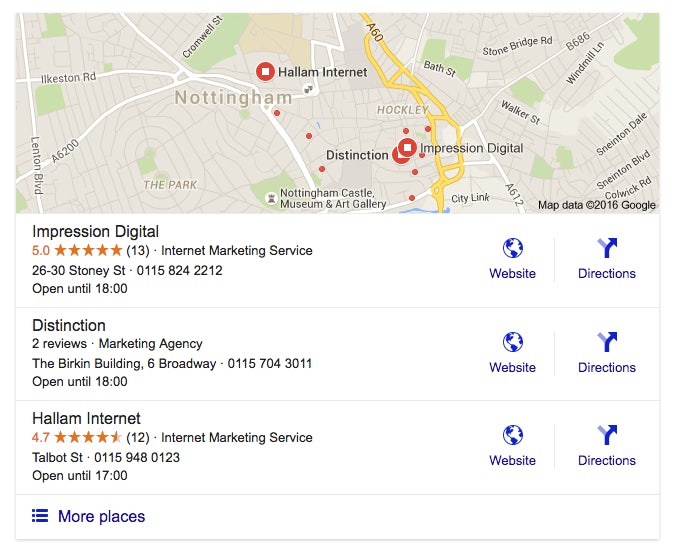In an unusually ‘T’ themed Impression Showcase, this week the team have been sharing interesting, useful and inspirational updates from the land of digital.
How to excel with ‘top rated products’
We’re all familiar with the concept of reviews.
And we can all agree that a product with more top rated reviews is likely to be more appealing than one with poor or no reviews.
Google is incorporating this into its paid ads, specifically in the Shopping feed. This will be part of the quality score algorithm from what we understand, meaning that it will likely be cheaper if not easier for products with a higher rating score and/or more ratings to outrank its competitors.
Don’t reviews already appear in the Shopping feed?, you may ask:
Yes they do. But this will be the first time reviews have been taken into consideration as an ad ranking signal. We wouldn’t be surprised if review ratings were part of the organic ranking algorithm too.
This is most likely to be relevant to ecommerce websites.
Here’s what you need to do to take advantage of this new feature once it arrives in the UK:
- Set your business up on an approved reviews platform – you can get a full list of those here.
- Encourage your customers to leave reviews
- Markup your reviews using schema on your website so Google knows where to find them
If you run an ecommerce website and would like to find out more about top rated product status and how to improve your visibility in the Shopping feed, get in touch and we’ll be happy to help.

Click-to-text ads coming soon
Click-to-call ads have been available for some time now.
(If you’re not already doing this, here’s how to add phone numbers on AdWords.)
Now Google is testing a ‘click to text’ format in its ads to enable users to text as well as call, direct from the search results. This was reported by Search Engine Land this week.
In its current state, the click to text functionality requires you to provide a mobile number to which texts can be sent. If you know that your audience is more likely to text than to call, this could be worth testing on your own ads.
Will local SEO get harder with local pack ad placements?
The local pack currently includes 3 business listings. But in the coming months, this will drop to 2 to make way for a paid ad spot.
This means:
- There will be fewer available spaces to rank in the local pack organically
- There will be a new ad format to include in your advertising plan
- Local businesses will need to up their game to appear in the local pack at all
Google wants to provide the local pack to aid searchers in finding the business or service they need. In order to appear in the local pack, companies must have a local presence and be able to serve that local audience.
Of course, it’s not as simple as that. Local businesses also need to ensure their Google My Business (especially Maps) listing is accurate and complete, that their citations are consistent and that they are relevant to the searcher intent.
As the number of local pack organic spots decreases, expect greater local competition. Savvy local businesses will already be considering how they can use the paid ad spot to their advantage – which, in theory, could lead to businesses appearing in 2 spots in the local pack.

Query analysis gets even more granular with Search Console update
Want to know which variation on a keyword is more successful for your business?
Google’s just made that easier for you, with the introduction of a new query comparison element in Search Console.
Here, you can compare metrics for similar keyword to identify which one works best for you and your audience. Search Engine Land provided this example:

This will be really powerful as a way of honing in on a specific keyword over another. While one page can theoretically rank for various semantically related phrases, your choice of which phrase is most prominent can be led by this insight.
URL Profiler Trial
If you know Impression, you’ll know we love data!
As well as developing our own internal tool to monitor SEO and PPC metrics, we invest in a wide range of external platforms designed to give us the insight we need to make better informed decisions and to achieve better results.
This month, we’re trialling URL Profiler as a link prospecting and auditing tool. So far, we really like that it pulls in data from Ahrefs, Majestic, Moz and SEMRush. We’ll report back on our findings. If you’ve used URL Profiler at all, feel free to share your opinions in the comments or tweet us @impressiontalk.
Build trust, improve conversion rates, make more money
If you sell products online, you’ll know that getting traffic to your website is only the first step to success.
The next is to encourage people to buy – and to buy more, at higher average sale prices (ASPs).
We work with a lot of ecommerce businesses. We use a range of tools to improve conversion rates (including Visual Web Optimiser, Google Experiments and Decibel Insights). One area Pete’s been looking at in depth with one of his ecommerce clients this week is trust signals.
Why are trust signals important?
Because they encourage people to buy from us.
When you don’t have a physical shop, it can be difficult to prove to potential customers that your shop can be trusted. They want to be sure that they’ll receive the product they want and that it will be of the quality they expect.
No one wants to give their money to an unknown entity.
Our client already uses a reviews platform, so that’s a great start. Our designer Beck has drafted a new section for their homepage which incorporates more trust signals, such as review ratings, established dates, refund policies and so on. We’ll be monitoring the resulting impact on conversion rates and would highly recommend such tests to any ecommerce business.
Track all the things!
Tracking is an essential element of any online campaign.
Without tracking, you don’t know how good a job you’re doing.
If you’re paying an agency and they’re not tracking results for you, how do you know what you’re paying for?
This week, Rob has been updating the URLs that show in the Knowledge Graph using the URL Builder to track visits. Without this, Knowledge Graph clicks show as ‘direct’ traffic. If you’d like to find out more, get in touch and we’ll be happy to help.
That’s all for this week! If you’ve spotted something interesting or cool in the world of digital that you’d like us to discuss at our next Showcase meeting, feel free to drop your ideas in the comments or tweet @impressiontalk using #showcase. Our team meets once a fortnight to discuss these things and your idea/tool/technique could be shared in our next instalment.



